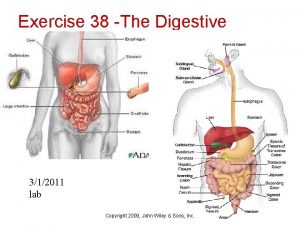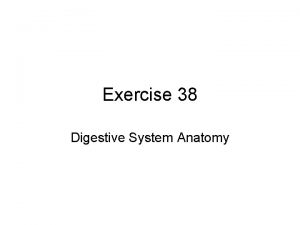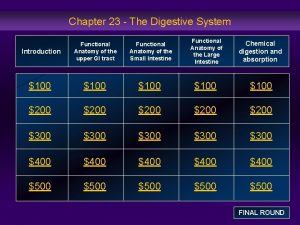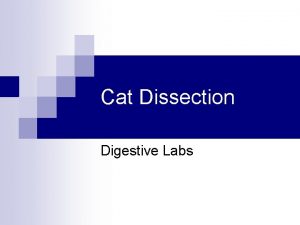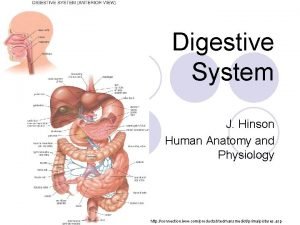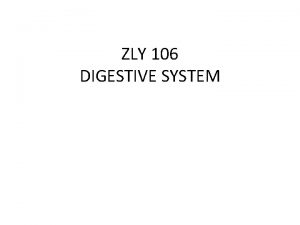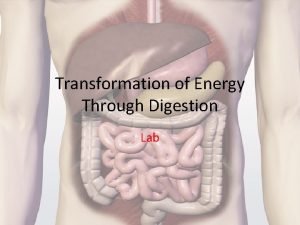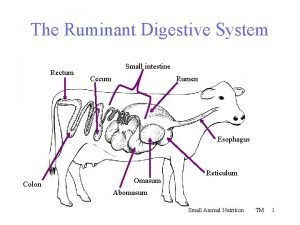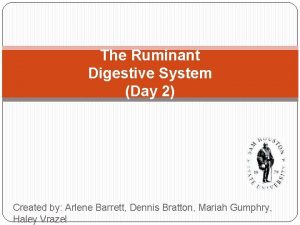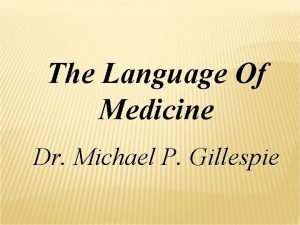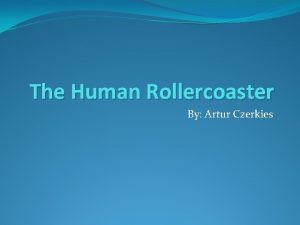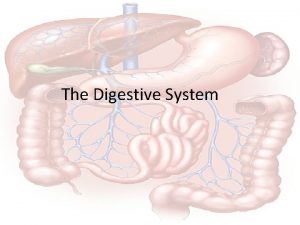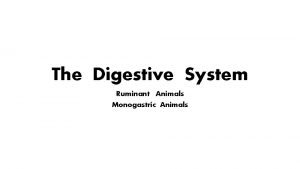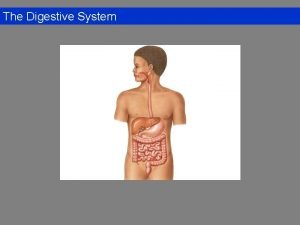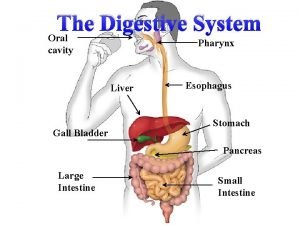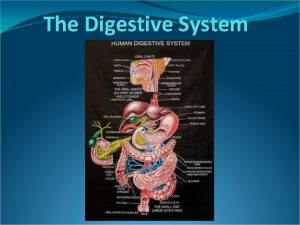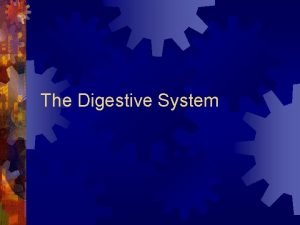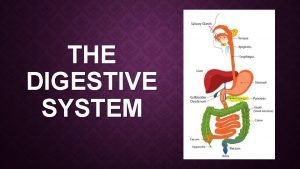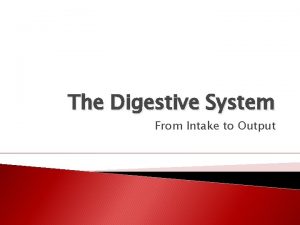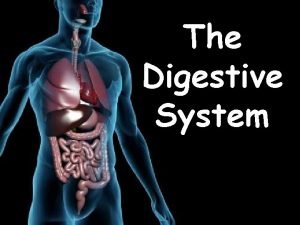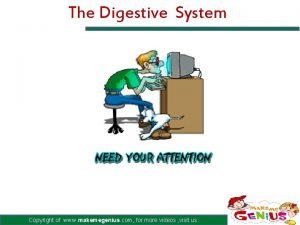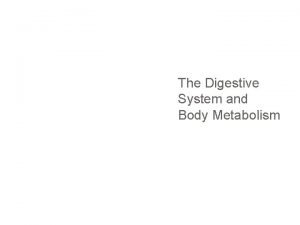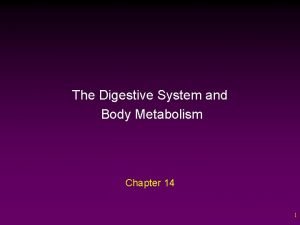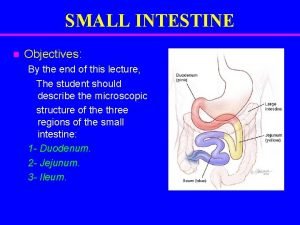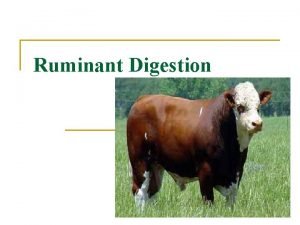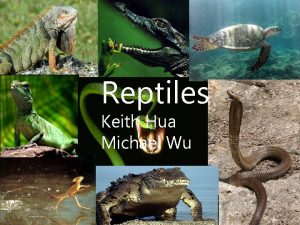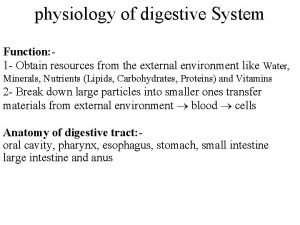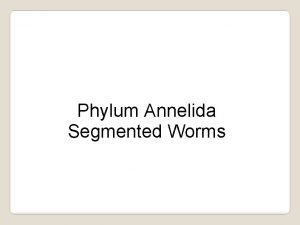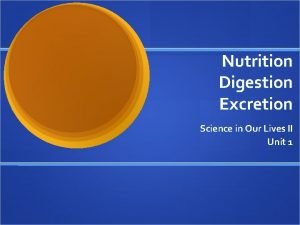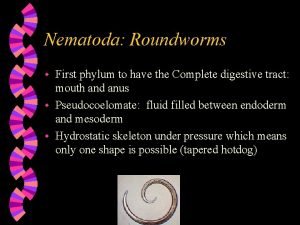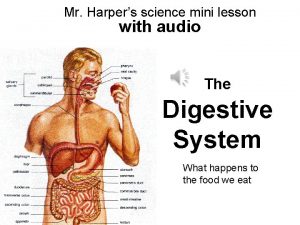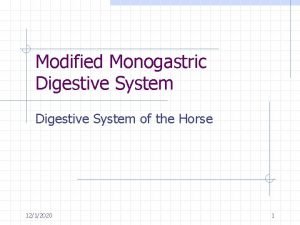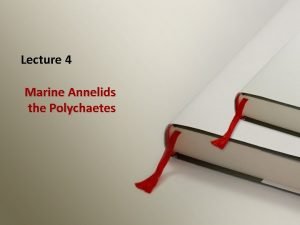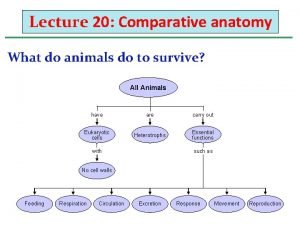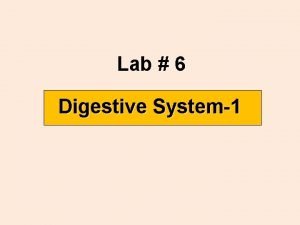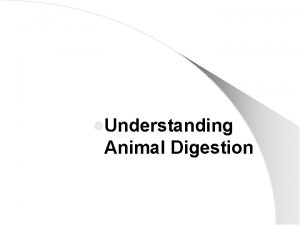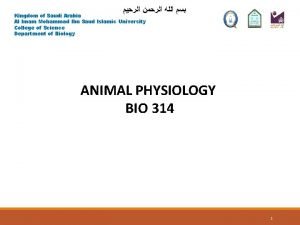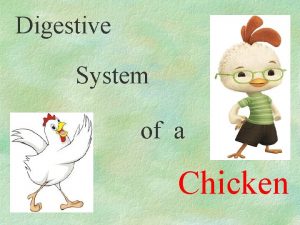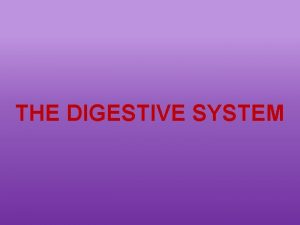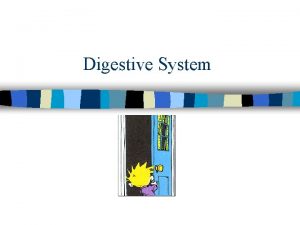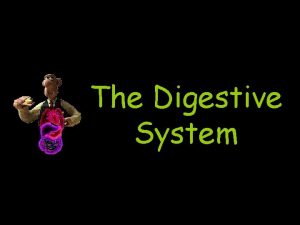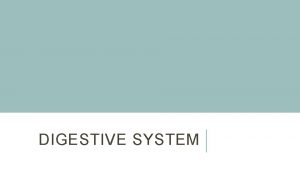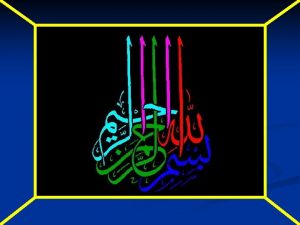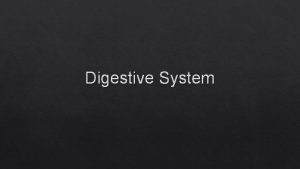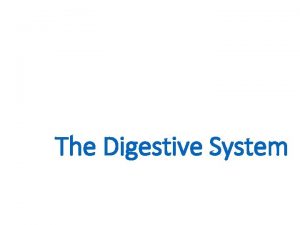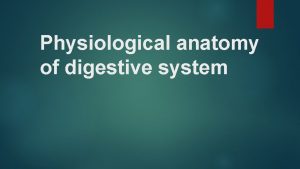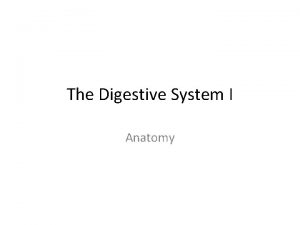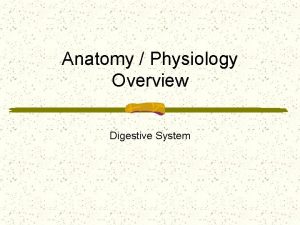Anatomy Ch 14 DIGESTIVE SYSTEM Anatomy of the






















































































- Slides: 86

Anatomy Ch. 14 DIGESTIVE SYSTEM

Anatomy of the Digestive System The alimentary canal is also called the gastrointestinal or GI tract The GI tract is a continuous, coiled, hollow, muscular tube The organs of the GI tract: Mouth Pharynx Esophagus Stomach Small intestine Large intestine

Mouth (oral cavity) The The The lips or labia protect the anterior opening cheeks form the lateral walls hard palate forms the anterior roof soft palate forms the posterior roof uvula is a projection of the soft palate tongue occupies the floor of the mouth and attaches to the hyoid bone and styloid process The lingual frenulum secures the tongue to the floor of the mouth The palatine and lingual tonsils are found in the posterior portion of the mouth and function in the lymphatic system


Pharynx Oropharynx is posterior to the oral cavity Laryngopharynx is continuous with the esophagus The pharynx contains 2 layers of skeletal muscles ○ Alternating contractions of these layers propel food through the pharynx into the esophagus (peristalsis)


Esophagus The gullet or food tube Runs from the pharynx to the stomach About 10 inches long Walls are composed of 4 tissue layers or tunics All of the remaining organs of the GI tract are composed of the same 4 layers


Mucosa Inner layer Lines the lumen Contains stratified squamous epithelium, connective tissue, and smooth muscle Submucosa Beneath the mucosa Connective tissue Contains blood vessels, nerve endings, MALT, and lymphatic vessels

Muscularis 2 layers of smooth muscle Serosa Outer layer Visceral and parietal peritoneum containing serous fluid


The wall of the GI tract contains 2 nerve plexuses Submucosal myenteric These plexuses are part of the ANS The plexuses regulate the mobility and secretory activity of the GI organs

Stomach Cardioesophageal sphincter: area of the stomach where food enters from the esophagus Fundus: expanded lateral part of the stomach Body: mid portion of the stomach Pyloric antrum: inferior narrow portion of the stomach Pyloris: funnel shaped terminal portion which is continuous with the small intestine Pyloric sphincter: valve between the stomach and small intestine

The stomach varies in length Diameter and volume depend on how much food it contains The stomach can hold up to 1 gallon of food When the stomach is empty it collapses forming folds called rugae The stomach is a temporary storage area and is the site for food breakdown The stomach contains 3 layers of muscle: longitudinal, circular, and oblique Having 3 layers of muscle allows the stomach to move and breakdown food

The chemical breakdown of proteins begins in the stomach The mucosa of the stomach produces a layer of mucus that protects the wall of the stomach from being damaged by acid or being digested by enzymes

Secretions of the stomach ○ Intrinsic factor: absorption of vitamin B 12 ○ Pepsin: digestion of proteins ○ HCl acid: makes the stomach contents acidic and activates pepsinogen ○ Gastrin: release of gastric juices and stomach emptying ○ Mucus: protects the stomach lining ○ Somatostatin: inhibits the activity of the stomach

Most digestive activity occurs in the pyloric region of the stomach After food has been processed in the stomach it becomes a creamy substance called chyme The greater omentum covers the abdominal organs ○ It is filled with fat which helps to insulate, cushion, and protect the abdominal organs


Small Intestine The body’s major digestive organ Food is prepared for delivery to the cells of the body Muscular tube that extends from the stomach to the large intestine Longest section of the GI tract Suspended from the abdominal wall by the mesentery

There are 3 divisions of the small intestine: duodenum, jejunum, and ileum (longest) The ileum meets the large intestine at the ileocecal valve which joins the small and large intestine Chemical digestion begins in the small intestine The pyloric sphincter controls the movement of food from the stomach to the small intestine

Secretions of the duodenum of the small intestine ○ Intestinal gastrin: stimulates gastric secretion and emptying ○ Somatostatin: inhibits gastric activity ○ Secretin: increases pancreatic juice and bile output ○ Cholecystokinin (CCK): increases pancreatic juice output and stimulates the gall bladder which allows the pancreatic juice and bile to enter the duodenum ○ Gastric Inhibitory Peptide (GIP): inhibits secretion of gastric juice and stimulates insulin release

The pancreatic and bile ducts release enzymes and bile into the duodenum through the hepatopancreatic ampulla Nearly all food absorption occurs in the small intestine The wall of the small intestine contains structures called microvilli which release brush border enzymes. These enzymes allow for digestion of proteins and carbohydrates.

Most of the absorptive structures are found at the beginning of the small intestine Large numbers of peyer’s patches (lymphatic) are found near the end of the small intestine



Large Intestine The large intestine is much larger in diameter than the small intestine but is smaller in length The large intestine extends from the ileocecal valve to the anus The major functions of the large intestine is to dry out the indigestible food residue by absorbing water and eliminate those residues from the body as feces.

The large intestine frames the small intestine and contains subdivisions: cecum, appendix, colon, rectum, and anal canal The appendix is attached to the cecum The colon is divided into 4 regions ○ Ascending: travels up the right side of the abdominal cavity ○ Transverse: travels across the abdominal cavity ○ Descending: travels down the left side of the abdominal cavity and enters the pelvis ○ Sigmoid: found in the pelvis

The anal canal ends at the anus which opens to the exterior The anal canal has 2 sphincters which control defecation ○ External: composed of skeletal muscle and is voluntary ○ Internal: composed of smooth muscle and is involuntary

There are no villi found in the large intestine because most absorption has already taken place There a large number of goblet cells that produce mucus which acts as a lubricant


Accessory Organs of Digestion Teeth Allow the process of mastication or chewing Humans have 2 sets of teeth in their lifetimes ○ Deciduous (baby) teeth Begin to erupt around 6 months Full set includes 20 teeth ○ Permanent teeth As the permanent teeth enlarge and develop the roots of the baby teeth are reabsorbed All of the permanent teeth but the 3 rd molars (wisdom teeth) have erupted by the end of adolescence Full set includes 32 teeth

We classify teeth according to shape and function ○ Incisors: chisel shaped adapted for cutting ○ Canines: tearing or piercing ○ Premolars (bicuspids) and molars: have broad crowns with rounded cusps for grinding

A tooth consists of 2 major regions: crown and root The crown is covered with enamel and is the exposed part of the tooth above the gingiva or gum Enamel is the hardest substance in the body and is mineralized by calcium salts The root is embedded in the jaw bone The root and crown are connected by a region called the neck

The outer surface of the root is covered by a substance called cement which attaches the tooth to the periodontal ligament which holds the tooth in place Dentin is a bone like material found under the enamel and forms the bulk of the tooth Dentin surrounds a central pulp cavity which contains blood vessels and nerve fibers Where the pulp cavity extends into the root it becomes the root canal


Salivary Glands There are 3 pairs of salivary glands: parotid, submandibular, and sublingual Saliva is a mixture of mucus and serous fluid ○ The mucus moistens and helps bind food together into a mass called a bolus ○ The serous portion contains an enzyme called salivary amylase that begins the process of starch digestion in the mouth Saliva also contains lysozyme and antibodies that inhibit bacteria growth Saliva dissolves food chemicals so they can be tasted

Salivary Glands 1) Parotid Gland 2) Submandibular Gland 3) Sublingual Gland

Pancreas Only the pancreas produces enzymes that break down all categories of digestible foods The pancreatic enzymes are secreted into the duodenum of the small intestine These enzymes neutralize the acidic chyme coming from the stomach The pancreas also produces insulin and glucagon


Liver Largest gland in the body The liver has 4 lobes and is suspended from the diaphragm by the falciform ligament The digestive role of the liver is to produce bile Bile leaves the liver through the common hepatic duct and enters the duodenum through the bile duct


Bile is a yellow to green watery solution that contains bile salts, bilirubin, cholesterol, phospholipids, and electrolytes Only the bile salts and phospholipids aid in the digestive process Bile salts physically breakdown fats

Gallbladder Found on the inferior surface of the liver When food digestion is not occurring bile enters the gallbladder to be stored Bile becomes concentrated while it is in the gallbladder Bile is released when fatty foods enter the duodenum of the small intestine


Functions of the Digestive System Overview The major functions of the GI tract can be summarized in 2 words: digestion and absorption Processes ○ Ingestion Voluntary process of placing food in the mouth ○ Propulsion Movement of food from one organ to the next Peristalsis: altering waves of contraction and relaxation of muscles

○ Mechanical digestion Physical breakdown of food into smaller pieces Mixing, churning, and segmentation ○ Chemical digestion Breakdown of large food molecules into their building blocks by enzymes Occurs by hydrolysis

Carbohydrates (mouth) - Broken down into monosaccharides or simple sugars - Glucose (most important), fructose (fruit), galactose (milk) - Only complex carbohydrates our digestive system breaks down are sucrose, lactose, maltose, and starch - The body is not able to breakdown the polysaccharide cellulose but it does help move food along the GI tract by providing fiber - Broken down by amylase

Proteins (stomach) - Broken down into amino acids - Peptides are the intermediate - Broken down by pepsin and trypsin Lipids (small intestine) - Broken down into fatty acids and glycerol - Broken down by lipase

○ Absorption Transport from the GI tract to the blood or lymph Food first enters the mucosal cells Small intestine is the major site ○ Defecation Elimination of indigestible residue in the form of feces

Digestive activity is mostly controlled by reflexes of the parasympathetic (rest and digest) division of the ANS. The most important stimuli for the GI tract is stretch, p. H, and products of digestion

Activities of the Mouth, Pharynx, and Esophagus Food ingestion and breakdown ○ Food is physically broken down in the mouth ○ Chemical digestion of carbohydrates by the enzyme amylase occurs in the mouth ○ Larger amounts of saliva form when food is present ○ No food absorption occurs in the mouth ○ The pharynx and esophagus have no digestive function.

Food propulsion – swallowing and peristalsis ○ Deglutition is the act of swallowing ○ Swallowing involves the activity of the tongue, soft palate, pharynx, and esophagus ○ Swallowing has 2 phases Buccal - Voluntary phase in the mouth - Bolus is forced into the pharynx by the tongue

Pharyngeal – esophageal - Involuntary process controlled by the vagus nerve of the ANS - All other routes are blocked off - Movement by peristalsis of longitudinal and circular muscles - Food enters the stomach once it opens the cardioesophageal sphincter.

Activities of the stomach Food breakdown ○ Secretion of gastric juice controlled by nervous system reflexes ○ The hormone gastrin is released which prods the stomach to release pepsinogens, mucus, and HCl ○ Acidic environment is necessary because it causes pepsinogen to become pepsin which actually digests proteins and rennin which digests milk proteins ○ Other than protein digestion very little chemical digestion occurs ○ The 3 layers of muscle in the stomach compress and pummel the food breaking it down physically

Food propulsion ○ In the stomach the process of peristalsis begins in the upper half of the stomach ○ Contractions increase in force as the food approaches the pyloric valve ○ The pylorus allows only liquids and very small particles to pass through the pyloric sphincter

○ Once the food has reached this point it is called chyme and moves into the small intestine in very small amounts ○ When the duodenum of the small intestine is filled with chyme, a reflex decreases gastric activity which slows the emptying of the stomach ○ It takes about 4 to 6 hours for the stomach to completely empty

Activities of the Small Intestine Food Breakdown and Absorption ○ By the time food reaches the small intestine, carb and protein digestion has begun but no fats have been digested ○ The process of chemical food digestion is accelerated ○ By the time food reaches the end of the small intestine, digestion is complete and nearly all food absorption has occurred

○ The small intestine releases brush border enzymes that break down double sugars into simple sugars and complete protein digestion ○ Protective mucus is probably the most important intestinal gland secretion ○ Foods entering the small intestine is deluged with pancreatic juice and bile ○ Pancreatic juice contains enzymes that: Completes the digestion of starch Carries out about half of protein digestion Are totally responsible for fat digestion using lipases Digest nucleic acids using nucleases

○ Pancreatic juices also contain bicarbonate which ○ ○ neutralizes the acidic chyme to provide the best environment for digestive enzymes When chyme enters the small intestine it stimulates the release of the hormones cholecystokinin (CCK) and secretin These 2 hormones influence the release of pancreatic juice and bile Secretin causes the liver to increase its output of bile and CCK causes the gallbladder to release stored bile Bile mechanically breaks down fat globules and is necessary for the absorption of fat soluble vitamins (A, D, E, K)

○ Absorption of water and products of digestion ○ ○ occurs all along the length of the small intestine Most substances are absorbed by active transport except lipids that are absorbed by diffusion Substances enter the capillary beds to be transported in the blood to the liver At the end of the small intestine (the ileum) all that remains is some water, indigestible food materials, and large amounts of bacteria This material enters the large intestine through the ileocecal valve

Food Propulsion ○ Peristalsis is the major means of propelling food through the intestine ○ It involves waves of contraction that move along its length followed by a wave of relaxation ○ Rhythmic segmental movements mix the chyme with the digestive juices and help propel food

Activities of the Large Intestine Food breakdown and absorption ○ The material that arrives at the large intestine has very few nutrients but still has 12 to 24 hours to spend there ○ The colon produces no digestive enzymes ○ The bacteria that live in the lumen of the large intestine metabolize some of the remaining nutrients releasing gases ○ Bacteria in the large intestine also make some vitamin K and B

○ The only material that is absorbed in the large intestine is vitamins, some ions, and most of the remaining water ○ Feces contains undigested food residues, mucus, bacteria, and just enough water to allow smooth passage

Propulsion of the residue and defecation ○ Contractions in the colon are sluggish and short lived ○ The slow segmented movements of the large intestine are called haustral contractions. These contraction last about 1 minute and occur every 30 minutes ○ Movement in the large intestine is from one haustrum to the next as it fills with food residue

○ Mass movements are long, slow-moving, ○ ○ ○ powerful waves of the colon that occurs 3 or 4 times a day. These movements force the contents toward the rectum They typically occur during or just after eating Fiber in the diet increases the strength of colon contractions and softens stool The defecation reflex occurs when feces is forced into the rectum and the wall is stretched During this reflex the walls of the colon and rectum contract and the sphincters relax The only anal sphincter that we have control of is the external one.

Metabolism Carbohydrate metabolism Carbohydrates are the preferred fuel of cells to produce ATP Glucose is the major breakdown product of carbohydrate digestion Glucose is also the major fuel used for making ATP in most body cells Glucose is broken apart piece by piece The chemical energy from the breakdown is used to bind a phosphate to ADP to make ATP

Stages of Cellular Respiration ○ Glycolysis Occurs in the cytosol of cells Each glucose is split into 2 molecules of pyruvic acid Hydrogen atoms are removed 2 ATP are produced ○ Krebs cycle Occurs in the mitochondria Produces all of the CO 2 in respiration Hydrogen atoms are removed 2 ATP are produced

○ Electron transport chain Occurs in the mitochondria Hydrogen atoms from the first 2 phases are split Electrons from the split give off energy that allows a phosphate to attach to ADP making ATP The electrons bind with hydrogen and oxygen to form water A large amount (32) of ATP is produced The process is called oxidative phosphorylation

Fat metabolism The liver handles most of the fat metabolism The liver uses some of the fats to make ATP Stored fats are the most concentrated source of energy For fat to be used to make ATP it must be broken down into acetic acid When the acetic acid is oxidized it forms CO 2, H 2 O, and ATP

Fats are used to produce ATP when there is not enough glucose Although fats are an important energy source, cholesterol is never used as cellular fuel Cholesterol is important in forming structures in the body Excess fats are stored Although fat is important as an insulator, it does restrict movement and places a greater demand on the circulatory system

Protein metabolism Proteins make up the bulk of cellular structures The liver processes blood and drains the digestive tract of amino acids Cells of the body remove amino acids from blood and uses them to build proteins Cells use ATP to transport amino acids into their interior even if there is already a large amount in the cell

The accumulation of amino acids will ensure that all the essential amino acids are available to build proteins. Amino acids are used to make ATP only when proteins are over abundant or when carbs and fats are not available When this occurs the amine groups of the amino acids are removed forming ammonia The rest of the molecule enters the Krebs cycle The liver combines the toxic ammonia with CO 2 to form urea. The urea is not toxic and is flushed out as urine

The Role of the Liver in Metabolism The liver is important in helping maintain blood glucose levels Glucose is stored as the polysaccharide glycogen when blood glucose levels are too high. The glycogen is stored in the liver The liver can also make glucose from fats and proteins The hormones thyroxine, insulin, and glucagon are important in controlling blood sugar levels


Some of the fats picked up by the liver are used to make ATP. The liver also secretes products into bile that breaks down cholesterol The liver produces proteins such as albumin, which holds fluid in the blood stream, and clotting proteins The liver synthesizes some nonessential amino acids and detoxifies ammonia by turning it into urea

The majority of cholesterol in blood is made by the liver Cholesterol is needed to build steroid hormones, vitamin D, and plasma membranes The lipoproteins (HDLs and LDLs) are made by the liver and play a role in fat and cholesterol transport Lipoproteins transport fats and cholesterol in the blood stream

LDLs (low density lipoproteins) transport cholesterol and other lipids to body cells If large amounts of LDLs are circulating there is a greater chance that fatty substances will be deposited on arterial walls HDLs (high density lipoproteins) transport cholesterol from the cells of the body to the liver for disposal as bile.

Body Energy Balance A dynamic balance exists between the body’s energy intake and it’s energy output: ○ Energy intake = total energy output (heat + work + energy storage) When energy intake and output are balanced, body weight remains stable It is believed that feeding behavior and hunger are regulated by neural signals from the GI tract, bloodborne signals from energy stores, hormones, body temperature, and psychological factors

All of these factors send feedback signals to the feeding centers of the brain located mostly in the hypothalamus Sensors in the liver and GI tract may also play a role in feeding behaviors

Metabolic rate and body heat production When nutrients are broken down to produce ATP they yield different amounts of energy ○ Carbohydrates and proteins – 4 kcal/gram ○ Fats – 9 kcal/gram Basal metabolic rate is the amount of heat produced by the body per unit of time when the body is at rest

○ BMR reflects the energy supply to just perform essential life activities ○ The factors that determine BMR include surface area, sex, thyroxine production (most important), age, and emotions ○ The person that would have the highest BMR would be a lean, tall, young male with high thyroxine production ○ The more thyroxine produced, the higher the oxygen consumption and ATP use, and the higher the BMR

Total metabolic rate ○ All types of activity increases the body’s caloric requirement ○ Total metabolic rate (TMR) refers to the total amount of kilocalories the body must consume to fuel activities ○ Muscular work is the major body activity that increases TMR

○ When total kilocalories is equal to TMR our weight remains constant ○ Excess kilocalories appear in the form of fat deposits ○ If we have high levels of activity, fat reserves are broken down in order to satisfy TMR. Tissue protein may also be broken down

Body temperature regulation ○ ATP is not the only product of nutrient breakdown ○ Most of the energy released from foods (60%) escapes as heat ○ Less than 40% of food energy forms ATP ○ Released heat warms tissues and, more importantly, the blood ○ The body’s thermostat is the hypothalamus which regulates body temperature

○ Heat promoting reactions Shivering is the involuntary contractions of voluntary muscles Shivering allows our body to produce more heat Vasoconstriction of blood vessels allows the body to conserve more heat During vasoconstriction blood is detoured to deeper organs

○ Heat loss reactions Most heat loss occurs through the skin by radiation and evaporation Radiation occurs when blood vessels dilate and heat radiates from the skin surface Evaporation is the removal of perspiration off of the skin surface Evaporation is more efficient if the air is dry and slower if the air is humid
 Site:slidetodoc.com
Site:slidetodoc.com Exercise 38 review sheet art-labeling activity 1 (1 of 2)
Exercise 38 review sheet art-labeling activity 1 (1 of 2) Greater omentum
Greater omentum Functional anatomy of the digestive system
Functional anatomy of the digestive system Digestive system cat dissection
Digestive system cat dissection Mucus c
Mucus c Nervous system and digestive system
Nervous system and digestive system Hình ảnh bộ gõ cơ thể búng tay
Hình ảnh bộ gõ cơ thể búng tay Bổ thể
Bổ thể Tỉ lệ cơ thể trẻ em
Tỉ lệ cơ thể trẻ em Voi kéo gỗ như thế nào
Voi kéo gỗ như thế nào Chụp tư thế worms-breton
Chụp tư thế worms-breton Hát lên người ơi alleluia
Hát lên người ơi alleluia Các môn thể thao bắt đầu bằng tiếng bóng
Các môn thể thao bắt đầu bằng tiếng bóng Thế nào là hệ số cao nhất
Thế nào là hệ số cao nhất Các châu lục và đại dương trên thế giới
Các châu lục và đại dương trên thế giới Công thức tính thế năng
Công thức tính thế năng Trời xanh đây là của chúng ta thể thơ
Trời xanh đây là của chúng ta thể thơ Cách giải mật thư tọa độ
Cách giải mật thư tọa độ 101012 bằng
101012 bằng độ dài liên kết
độ dài liên kết Các châu lục và đại dương trên thế giới
Các châu lục và đại dương trên thế giới Thể thơ truyền thống
Thể thơ truyền thống Quá trình desamine hóa có thể tạo ra
Quá trình desamine hóa có thể tạo ra Một số thể thơ truyền thống
Một số thể thơ truyền thống Cái miệng bé xinh thế chỉ nói điều hay thôi
Cái miệng bé xinh thế chỉ nói điều hay thôi Vẽ hình chiếu vuông góc của vật thể sau
Vẽ hình chiếu vuông góc của vật thể sau Nguyên nhân của sự mỏi cơ sinh 8
Nguyên nhân của sự mỏi cơ sinh 8 đặc điểm cơ thể của người tối cổ
đặc điểm cơ thể của người tối cổ V cc cc
V cc cc Vẽ hình chiếu đứng bằng cạnh của vật thể
Vẽ hình chiếu đứng bằng cạnh của vật thể Fecboak
Fecboak Thẻ vin
Thẻ vin đại từ thay thế
đại từ thay thế điện thế nghỉ
điện thế nghỉ Tư thế ngồi viết
Tư thế ngồi viết Diễn thế sinh thái là
Diễn thế sinh thái là Các loại đột biến cấu trúc nhiễm sắc thể
Các loại đột biến cấu trúc nhiễm sắc thể Thế nào là số nguyên tố
Thế nào là số nguyên tố Tư thế ngồi viết
Tư thế ngồi viết Lời thề hippocrates
Lời thề hippocrates Thiếu nhi thế giới liên hoan
Thiếu nhi thế giới liên hoan ưu thế lai là gì
ưu thế lai là gì Hổ sinh sản vào mùa nào
Hổ sinh sản vào mùa nào Khi nào hổ con có thể sống độc lập
Khi nào hổ con có thể sống độc lập Hệ hô hấp
Hệ hô hấp Từ ngữ thể hiện lòng nhân hậu
Từ ngữ thể hiện lòng nhân hậu Thế nào là mạng điện lắp đặt kiểu nổi
Thế nào là mạng điện lắp đặt kiểu nổi Deer digestive system
Deer digestive system Monogastric
Monogastric What energy transformations take place during digestion
What energy transformations take place during digestion Conclusion of digestive system
Conclusion of digestive system Cecum ruminant
Cecum ruminant Define ruminant digestive system
Define ruminant digestive system øhuman digestive system
øhuman digestive system Digestive system roller coaster project
Digestive system roller coaster project Human digestive system facts
Human digestive system facts Ruminant animals
Ruminant animals Serosa vs adventitia
Serosa vs adventitia Larynx function in digestive system
Larynx function in digestive system Introduction to digestive system
Introduction to digestive system Double sheets of peritoneal membrane
Double sheets of peritoneal membrane Pepto bysmol
Pepto bysmol Output of digestive system
Output of digestive system Intestine
Intestine Rugae
Rugae Digestive system make me genius
Digestive system make me genius Figure 14-1 digestive system
Figure 14-1 digestive system Digestive system body
Digestive system body Biggest muscle in human body
Biggest muscle in human body M cells
M cells What image is this
What image is this Turtle digestive system
Turtle digestive system Amylase function
Amylase function Cnidae
Cnidae Trocophore larva
Trocophore larva Digestive system order
Digestive system order Jblem
Jblem Correct order of digestive system
Correct order of digestive system Horse monogastric digestive system
Horse monogastric digestive system Polychaete respiration
Polychaete respiration Respiratory organs of invertebrates
Respiratory organs of invertebrates Hagfish characteristics
Hagfish characteristics The microscopic structure of the small intestine
The microscopic structure of the small intestine Swine digestive system
Swine digestive system Is a heart an organ system
Is a heart an organ system

